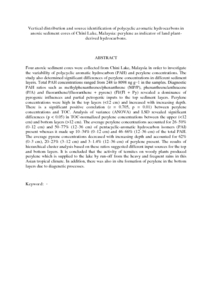Citation
Bakhtiari, Alireza Riyahi and Zakaria, Mohamad Pauzi and Lajis, Nordin and Yaziz, Mohammad Ismail and Bi, Xinhui and Che Abd Rahim, Mohamad
(2009)
Vertical distribution and source identification of polycyclic aromatic hydrocarbons in anoxic sediment cores of Chini Lake, Malaysia: perylene as indicator of land plant-derived hydrocarbons.
Applied Geochemistry, 24 (9).
pp. 1777-1787.
ISSN 0883-2927
Abstract
Four anoxic sediment cores were collected from Chini Lake, Malaysia in order to investigate the variability of polycyclic aromatic hydrocarbon (PAH) and perylene concentrations. The study also determined significant differences of perylene concentrations in different sediment layers. Total PAH concentrations ranged from 248 to 8098 ng g−1 in the samples. Diagnostic PAH ratios such as methylphenanthrenes/phenanthrene (MP/P), phenanthrene/anthracene (P/A) and fluoranthene/(fluoranthene + pyrene) (Fl/(Fl + Py) revealed a dominance of pyrogenic influences and partial petrogenic inputs to the top sediment layers. Perylene concentrations were high in the top layers (<12 cm) and increased with increasing depth. There is a significant positive correlation (r = 0.705, p = 0.01) between perylene concentrations and TOC. Analysis of variance (ANOVA) and LSD revealed significant differences (p < 0.05) in TOC-normalized perylene concentrations between the upper (<12 cm) and bottom layers (>12 cm). The average perylene concentrations accounted for 26–50% (0–12 cm) and 50–77% (12–36 cm) of pentacyclic-aromatic hydrocarbon isomers (PAI) present whereas it made up 10–34% (0–12 cm) and 46–66% (12–36 cm) of the total PAH. The average pyrene concentrations decreased with increasing depth and accounted for 62% (0–3 cm), 20–23% (3–12 cm) and 3–1.4% (12–36 cm) of perylene present. The results of hierarchical cluster analysis based on these ratios suggested different input sources for the top and bottom layers. It is concluded that the activity of termites on woody plants produced perylene which is supplied to the lake by run-off from the heavy and frequent rains in this Asian tropical climate. In addition, there was also in situ formation of perylene in the bottom layers due to diagenetic processes.
Download File
![[img]](http://psasir.upm.edu.my/17594/1.hassmallThumbnailVersion/Vertical%20distribution%20and%20source%20identification%20of%20polycyclic%20aromatic%20hydrocarbons%20in%20anoxic%20sediment%20cores%20of%20Chini%20Lake.pdf)  Preview |
|
PDF (Abstract)
Vertical distribution and source identification of polycyclic aromatic hydrocarbons in anoxic sediment cores of Chini Lake.pdf
Download (188kB)
| Preview
|
|
Additional Metadata
Actions (login required)
 |
View Item |

